IMPROVE MY GAME
Articles
Improving from the Ground Up: How the Function of the Ankle and Foot Influence Your Swing
In order to generate proper power with stability and balance, a solid base is critical. An unstable base has the potential to introduce a number of swing faults. Something as simple as curled toes or tight arches can be a precursor (or influencer) of characteristics such as loss of posture (especially by standing up), over-rotation (over-swinging), or too much lateral motion (swaying and sliding).
During my SwissFit Golf Assessment, I always observe the mobility of the feet, especially in flexion-extension, eversion-inversion and how these movements transfer to the chain up to the knees and hip joints. One example of how stability and balance is compromised is when people curl their toes. Golfers lose power by not being able to transfer their weight from the stable or “grounded” back leg to the front leg. This is a key factor to properly use the forces from the ground into the body and onto the club and golf ball (proper kinematic sequence in the downswing). For instance, the inward movement in the back foot during the downswing is essential because it helps rotate the pelvis, otherwise the pelvis could thrust forward when the heel comes up too early instead of rolling the foot inside (often due to tight ankles). For some golfers this is their first initiation movement to transfer their weight to the front side.
When you are at the driving range, I suggest you take off your shoes for an experiment. Notice what your feet do in your set up and then during the swing. Can you absorb the weight into the ground with soft and responsive ankles or are you holding them too tight? Are you rolling the back foot onto the outside in the backswing and the knee gets unstable?
- Do a quick self test: stand upright with the feet together, turn your whole body like you want to see what is behind you. If you feel any discomfort in knees, hips or back, most likely you are not turning in the feet. Also feel the entire sole of your feet with the toes long and relaxed. The weight on the feet should be evenly distributed from the heels to toes. The ankles soft so they can turn slightly as you rotate. Lack of movement in the feet can result in an overuse in any of the joints mentioned above or over time create joint pain or arthritis in knees or hips.
Here are some tips how you can keep your feet supple and train them for a proper swing action and ultimately a better golf performance:
Exercise 1: In & Out & All Around
Benefits: Improves Balance and Weight Transfer
Starting Position: Sit on a chair with the feet standing.
-
Put two fists between your knees
-
Roll the feet in and out and feel how easy or how hard it is.
-
Are there any differences from left to right?

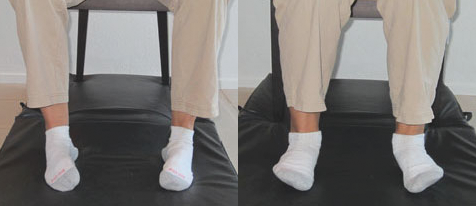
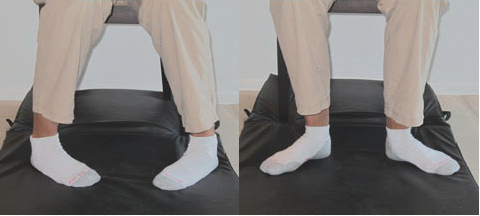
Movement Series:
- Lift all 10 toes off the floor and flex your feet, several times.
- Lift the heels high and bend at the ankles, several times.
- Lift the instep of both feet, the knees can open several times.
- Lift the outside of both feet, the knees can come closer several times.
- Fan the toes open like a windshield wiper several times.
- Fan the heels open like a windshield wiper several times.
- Make circles with both heels, keep the front of your toes on the ground. Keep the knees in place. Move them in both directions.
Repeat all the above and do it with the least amount of effort possible. Learn from the easier side and apply the lightness of the movement to the tighter side. Compare with the beginning. Walk around and feel your feet, then go in your set up and feel how you are grounded into the floor.
In these movements you should focus on isolating movement in the ankles, keeping the hips and knees still. If you are unable to do this, there are a number of variations you can perform with pattern assistance.
Exercise 2: Standing on a Tennis Ball
Benefits: Improves Balance and Weight Transfer
Starting Position: Come to stand with one foot on a tennis ball.
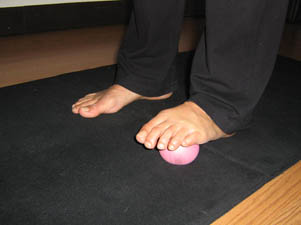
Movement Series:
- Stand with the ball of your left foot on 1 Tennis ball, allow your weight to shift from the big toe to the pinky toe, keep your body balanced.
- Stand with the ball under your heel and balance.
- Stand with the ball under your middle of the foot and balance
- Have the ball under each Metatarsi (junction toes and middle foot) and shift your weight – Forward and backwards – Left & Right – Circle the whole body in both directions keep the head stillWalk a few steps and compare both sides. Which foot is easier to roll over? On which side are you more stable?
- Repeat everything with the right foot. Compare the stability in your set up and during the Golf Swing.
TPI Certified strength coach Nick Buchan demonstrates this move (below) in a great blog post about techniques and considerations for improving dorsiflexion.
Exercise 3: Interlace Hands in Feet
Benefits: Improves Ankle and Feet Mobility and helps with Balance and Weight Transfer
Starting Position: Sit and bring the left foot on top of the right knee. Take the right hand and interlace the fingers in the toes of the left foot.
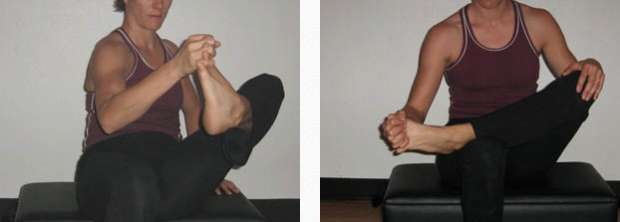
Movement Series:
- Lift the foot and circle the leg, allow the weight to shift forward and backwards, from one buttock to the other. Make sure you lean on the other hand to distribute the weight. Circle in both directions.
- Keep the foot on the knee, circle the foot in both direction. Look for smooth movements and release in tension in the arch of the foot, ankle joint and lower leg. Change over to the other hand on the same foot.
- Move the heel in opposite direction to the front of the foot, help with the other hand
- Pull on your toes, lengthen and turn each toe, bend and extend, especially big toe. Forward and backwards.
Repeat with other foot, interlace the left hand with the right foot.
Exercise 4: Sit back on Heels
Benefits: Improves Hip- and Ankle Flexibility for a good hip hinge at set up and Balance. Releases Low Back Tension.
Starting Position: Come on your hands and knees, the knees wide apart.
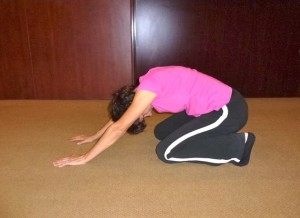
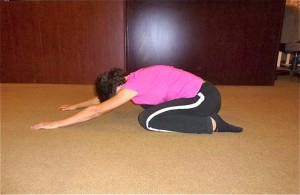
Movement Series:
- Sit back towards the heels as you keep the hands in place. Lengthen the back and spine and gradually and sit deeper into the hip joints. Repeat it several times slowly.
- Sit back as before but this time tuck your toes under and bring the pelvis towards the heels. Let the soles of the feet and the ankles soften each time as you sit back towards the heels.
- Keep the feet long and sit back again towards the heels and feel the difference. Repeat the whole movement several times.
Special Attention: Let the back lengthen as you sit back. Don’t strain your neck or shoulders. Keep the hands in place at all times. Sit back gradually and slowly if you experience tightness do NOT move into any pain. Stay in a comfortable range so your body can adjust and change. Repeat this each morning for best effect.
These exercises won't single-handedly cure your slice or have you hitting your driver 300 yards, but they will help you build a solid foundation and raise your ceiling for improvement.

Daniela Schellenberg is a Functional Movement Analyst and owns SwissFit Golf in Palm Springs, CA. She has over 24 years of experience in working in athletic environments as well as with professional golfers. Her unique approach applying the Feldenkrais Method into Functional Movement Training offers Golfers of all levels an opportunity to take their game to the next level or recover from injuries and stay healthy for the long run. She holds a Masters in Human Movement Science, Exercise Physiology and Sports Teaching from University of Zurich, Switzerland, is certified in the Feldenkrais Method (4 Year Study of Somatic Learning /Neurodifferenciation through Movement) and is certified by the Titleist Performance Institute (Level 3 Medical). Phone: 1-858-715-0255 Email: daniela@swissfitgolf.com Website: www.swissfitgolf.com